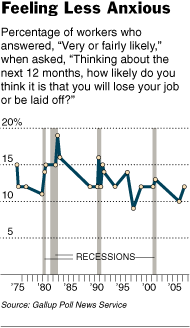 Source of graph: online version of the NYT article cited below.
Source of graph: online version of the NYT article cited below.
(p. C1) Last week, the Congressional Budget Office released a study that was arguably the fullest picture of (p. C12) economic volatility anyone has yet put together. Although some academics have taken a crack at the topic in recent years, they have had to rely on surveys in which people are asked how much money they make. The study by the C.B.O., as the budget office is known, used Social Security Administration records, which cover many more people than the surveys and are more reliable.
If you read the C.B.O. report, you can tell that its authors knew they were dealing with a delicate subject. The summary starts by noting that a “significant number of workers experience substantial variability in their total wage earnings,” which is certainly true. Only later do you come to the surprising part: there is the same amount of variability now that there was in the 1980s and 1990s. In journalism, this is known as burying the lead.
“Intuitively, you would think volatility is increasing,” said Senator Charles E. Schumer, Democrat of New York, who along with Senator Jim Webb of Virginia requested that the study be done. “But it isn’t, which I guess shows that the American economy has always been very flexible.”
Mr. Schumer’s point about intuition is an important one. We can all tick off reasons that the economy feels so volatile. Hardly a week goes by without another big corporation — the Tribune Company, Citigroup, DaimlerChrysler — announcing a big job cut. The number of temporary jobs, meanwhile, has mushroomed. Globalization and technological innovation are causing many of these changes, and labor unions are too weak to prevent them.
But there is also a whole set of other forces, harder to see and pushing in the other direction. Manufacturing, where furloughs and layoffs have always been the norm, accounts for a much smaller part of the work force than it used to, while more stable industries, like health care, have grown. This is one reason that recessions, and the job cuts they bring, haven’t happened as often as they once did.
. . .
In fact, research by Henry S. Farber, an economist at Princeton, has found that job loss rates have followed a cyclical pattern since the early ’80s, peaking around the same highs during recessions and falling to similar lows during expansions. (The rate has risen for workers who went to college and fallen a bit who those who didn’t.)
Americans, looking at their own jobs, realize that there hasn’t been a big change: in a recent Gallup Poll, 12 percent of respondents said it was very or fairly likely they would be laid off in the coming year. In the 1970s, ’80s and ’90s, at similar points in the business cycle, the percentage was virtually identical.
For the full commentary, see:
(Note: ellipses added.)

